
Callander Scotland was the inspiration for our municipality’s name; the original Callander is located in the beautiful Loch Lomond & Trossachs National Park in central Scotland, an hour north from Glasgow.
The name Callander is supposed to be derived from the Gaelic name ‘calladh’ meaning ‘ferry’ or ‘the way leading to the ferry’. This refers to the ferry that crosses the River Teith. Another source suggests that it is named after the Barony of Callandar in Falkirk which at one time owned the old riverside village.
The history of the area is colourful with a legacy of feuds, battles, murders and legends going all the way back to the Romans. Real life hero and warrior, Rob Roy MacGregor, (who inspired the movie “”Rob Roy”" starring Liam Neeson & Jessica Lange) is a local legend.
Coincidentally, our community has a lot in common with our namesake. They have a population of approximately 3,000; their prime industry is tourism; they are situated close to a “”loch”" (lake) and they have great fishing!
Our municipality maintains ties with their community. In August of 2003, local residents Jack and Julie Tipler, visited Scotland and were given a special reception by Callander town council.
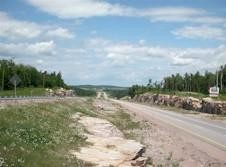 Most of Northern Ontario’s rocky landscape is part of the Canadian Shield that was created during the Precambrian Age over 570 million years ago. The North’s thriving mining industry owes its existence to the formations created by volcanic eruptions and earthquakes during this violent geological period.
Most of Northern Ontario’s rocky landscape is part of the Canadian Shield that was created during the Precambrian Age over 570 million years ago. The North’s thriving mining industry owes its existence to the formations created by volcanic eruptions and earthquakes during this violent geological period.
The low lying area between North Bay’s Airport Hill escarpment and the Almaguin Highlands (to the south) was formed when a fault parted to form the French and Mattawa River system. Today, you can see evidence of the Precambrian bedrock and granite in the rock cuts along the region’s Highway 11 corridor.
Following the Precambrian era, the region was submerged beneath raging seas where lime, clay and sand were deposited. All of this helped form the basic environment of the Lake Nipissing passageway – millions of years before the first Ice Age.
The local terrain was forged by the succession of ice ages that began 80,000 years ago. In approximately 8,000 B.C., the last retreat melted ice that flooded the landscape, creating Lake Nipissing and its various outlets including Callander’s Wasi River. The entire area was blanketed with “glacial till” – a mixture of sand, gravel and boulders that shaped moraines into a variety of landforms. Back then, Callander Bay probably looked as it does today with the exception that the forest cover was then complete.
It is thought that the first humans to reside around Lake Nipissing probably arrived around the retreat of the Ice Age some 10,000 years ago. Historically, these people are known as “”Paleo-Indians”". They would have lived by hunting game with primitive stone weapons and gathering berries and roots. Occasionally, archaeological remnants are unearthed throughout Ontario that shows proof of their existence.
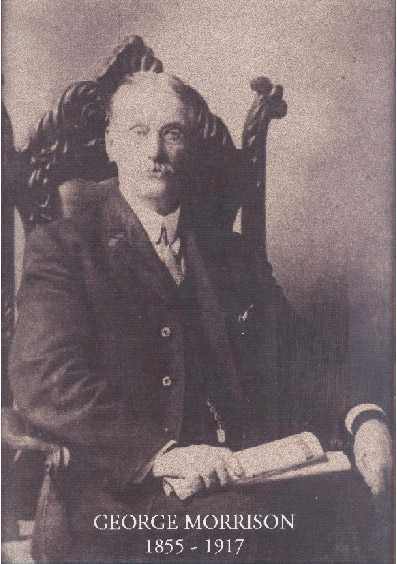 In 1880, a bookkeeper from Oxford County in Southern Ontario traveled by ox-cart from Muskoka to Lake Nipissing. There he built a raft and floated his family and possessions across the lake to the south-east bay. Logging companies had settled around its shores, taking advantage of the abundant white pine that grew in the area. He was one of its first pioneers and his wife was the first white woman. On June 1st 1881, George Morrison opened a Post Office in his general store and named it after his parent’s birthplace, Callander.
In 1880, a bookkeeper from Oxford County in Southern Ontario traveled by ox-cart from Muskoka to Lake Nipissing. There he built a raft and floated his family and possessions across the lake to the south-east bay. Logging companies had settled around its shores, taking advantage of the abundant white pine that grew in the area. He was one of its first pioneers and his wife was the first white woman. On June 1st 1881, George Morrison opened a Post Office in his general store and named it after his parent’s birthplace, Callander.
In homage to Mr. Morrison, Callander’s first Reeve, the municipality recently adopted the Ancient Morrison tartan as the official tartan of the community. Besides Scotland, early Callander residents primarily claimed ancestry from England, Ireland and France.
For the small logging community of Callander, a lot changed on the night of May 28, 1934. Five identical baby girls, the world’s first surviving Quints, were born to the Dionne family, farmers in the neighbouring village of Corbeil. Dr. A.R. Dafoe, Callander’s doctor assisted in the births and cared for the babies afterward.
Thus began the legendary story of the Dionne Quintuplets – an event that at the height of the Depression drew thousands of curious visitors and throngs of international media to this tiny village on the shores of Lake Nipissing. The Quints story is both fairytale and tragedy. They were world famous from birth but later it came to light that they were also horribly exploited and used by many who capitalized on their fame and who pocketed the results for their own greed. Historically, Callander’s identity was forever altered by the event of their births.
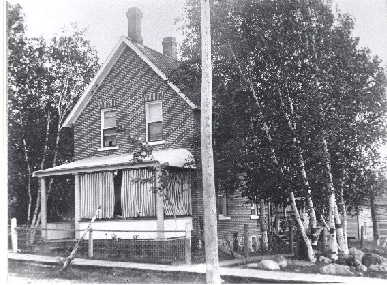
Callander Bay is located south-east off of Lake Nipissing in Northeastern Ontario and had connections to both the Grand Trunk Railway (later the Canadian National Railway), which was the main north-to-south train in Ontario, and the Canadian Pacific Railway, the main east-to-west train in Canada. It is also a protected bay which would make log booms less likely to spill and scatter during storms. The location, the abundance of white pine in the area, and transportation lines made it an attractive location for lumber barons to come and build mills in the area, with one still in operation today.
White pine was credited as the dominant factor for the growth and development of Ontario in a Ministry of Natural Resources booklet entitled “Ontario Celebrates its History: White Pine” (1984) because of its ability to float down rivers and in lakes (unlike harder woods), its long and knot-free trunks, and its resiliency to warping and cracking. In the early 1880s, John Rudolphus (J.R.) Booth, a known lumber tycoon from the Ottawa area, expanded his J.R. Booth Lumber Company into the Lake Nipissing region to harvest this good quality lumber.
By 1882 Booth has secured rights in the area and began planning for the construction of a railway from Callander Bay at the mouth of the Wasi River to Lake Nosbonsing, which is the present-day Astorville. The construction of the Nosbonsing and Nipissing Railway (N & N Ry) was made easier due to the earlier Canada Central Railway line to Bonfield in 1878 and was completed in 1885.
In Wisawasa, at the mouth of the Wasi River, a jack ladder was built to load logs from the lake into the bed of a flatcar. The large tough and chain with teeth would catch logs and pull them up along the trough where they would be stamped with Booth’s timber mark and then loaded and secured. Twenty-two cars full of logs could be taken to Lake Nosbonsing at a time and on average 4,000 logs could be transported daily.
By the 1900s Booth was the largest timber limit owner in the British Empire covering over 4,000 square miles in Ontario and Québec. His jack ladder allowed the transport of lumber by railway to Lake Nosbonsing where the logs would be floated to the Ottawa River by the Kaibuskong and Mattawa Rivers.
John B. Smith & Sons operated the longest running mill and was one of the largest employers in Callander. Their first mill was located on Frank’s Bay on the south-west shore of Lake Nipissing. The mill then moved to Callander when the projected C.P.R. route was to travel north of Lake Nipissing, rather than south. This was important because the railway access made it easier to transport the lumber to the various markets in the south. At the Callander location the mill opened in 1888, burned down in 1894 and was rebuilt 1400 feet west of its original location that same year.
The Great Depression of the 1930s hit the area lumber mills hard. According to Pierre Berton’s The Dionne Years, “…the average wage in a lumber mill in the Callander area was only twelve dollars for a sixty-hour week. By 1934, four of the five mills had closed its doors. The woolen mill, the tannery, the paddlewheel steamer that had been the outward symbols of the community’s prosperity at the turn of the century were long gone. In the year of the quintuplets’ birth, Callander was merely an abandoned lumber town of box-frame buildings...” (page 22). The Smith Mill had planned to reopen its door for six weeks and employ 150 men in 1934 which would have been hopeful news for a town with 70% of the population on relief payments. Unfortunately, it burned down again only two days before it was set to reopen. Eight days later, the Dionne quintuplets were born, and their birth would breathe money and prosperity back into the struggling area.
The Smith Mill would rebuild and open again in 1935 where it continued to operate until 1967. Doug Smith, the last owner, set fire to the mill as a final goodbye.
There were other mills around Callander Bay. The current Callander Industries Limited Mill (known as Gary Mote’s Mill) operates at the end of Park Street has been the site of many other mills over the years. John McBurney and Mr. Leacock built the first mill at that site back in 1892 before their partnership dissolved a few years later. Thomas Darling and his sons opened a mill on that site not long after, and by 1915 the mill was owned by A.B. Gordon. In 1923 it became the Canadian Timber Company and was still owned by Gordon. It was rebuilt in 1927, still as the Canadian Timber Company, but it was now owned by Wilkinson, McLaren, Scarlet and Armstrong. In 1934 this mill donated lumber siding to the building of the Dafoe Hospital for the Dionne Quintuplets down the road in Corbeil, the new home of the famous five identical sisters. It closed in the early 1940s and the current mill was built in 1964 and is still in operation.
The other major mill on Callander Bay was owned by John Payette of Penetang, Ontario. The Payette Lumber Company operated from 1929 to 1934 (although the main mill burned down in 1932 and was never rebuilt). Later, a Dine and Dance club was built on the location and today, the jack ladder base and burner base are still visible, just north of South Beach in Callander.
The Callander Bay Heritage Museum is located in the former home and practice of Dr. Allan Roy Dafoe, world famous country doctor of the Dionne Quintuplets and has been open to the public for over 35 years. The building itself, however, is over 100 years old and is a designated heritage building.
Prior to 1883 the property was Crown land. Through a Land Grant the 100 acre lot (Lot 2 Concession 26) was awarded to George Kilby who settled in Callander in 1883; Kilby did not develop the property, but kept it until 1886 when he sold it to Silas Huntington. Silas Huntington, a Methodist missionary, was credited with reaching many northern communities. Huntington kept the land until 1904. Once again, the property was not developed. John McBurney, born in 1863, was a lumber mill operator who owned McBurney’s Lumber Mill (the present site of Centennial Park). McBurney purchased the property from Huntington in May of 1904. He built a six room house; the same month, John McBurney sold the house to his wife, Marie, for the sum of $1.00 so as to protect his asset from possible bankruptcy. They kept the house until 1910.
John Darling, again a lumber entrepreneur, bought the property in March of 1910; as did McBurney, he sold the property to his wife, Kathleen within a month for the same reasons. One of John and Kathleen’s sons, Stan Darling (who was born in the house), was elected MP in the 1972 federal election. The Darling family lived in the home until 1914.
In June of 1914 Dr. Allan Roy Dafoe purchased the property; this was the year that he married Bertha Leila Morrison, a Red Cross nurse with whom he often worked. The Dr. used the house as his home and practice. Since the two front rooms were used for his practice, the Dr. immediately added a kitchen dining area to the east side of the house. He later added the reading room on the westerly side of the house. For many years Dr. Dafoe was a little-known country doctor that suddenly rose to international fame for his involvement with the birth of the Dionne Quintuplets. Upon the sudden death of Dr. Dafoe in 1943, his brother, Dr. William Dafoe of Toronto, came to settle his brother’s estate.
The house was sold twice after; first to Arthur Dunlop who owned the property from 1943 to 1967 then to Henry and Jacqueline White from 1967 to 1979.
With the determination of Alex Dufresne and several others the property was purchased from the Whites by the Corporation of the Township of North Himsworth in 1979 with the specific intent to have a community museum. Within two years the museum was open to the public and features eight rooms of area artifacts and history. In 1995 an addition was built onto the museum on the south end of the building. This addition is now an art gallery, and in honour of the vision of Alex Dufresne it is now known as the Alex Dufresne Gallery

The Birth
On May 28, 1934, Dr. Allan Roy Dafoe was called to the house of Oliva and Elzire Dionne to help with a pregnancy. When he arrived, Douilda Legros and Mary-Jeanne Lebel, two local midwives, had delivered two tiny babies and were in the midst of a third arriving. Dr. Dafoe took over the delivery of the last two births and helped Mrs. Dionne recover, as she was very ill. Yvonne, Annette, Cécile, Emilie and Marie were welcomed into the world.
The premature infants were placed in a basket and set upon a chair in front of the open door of the oven and were primarily left alone, as the doctor tended to Mrs. Dionne. The babies were bathed in warm olive oil and fed a combination of water, corn syrup and rum using an eye dropper. This would stimulate their blood flow and heart rate.
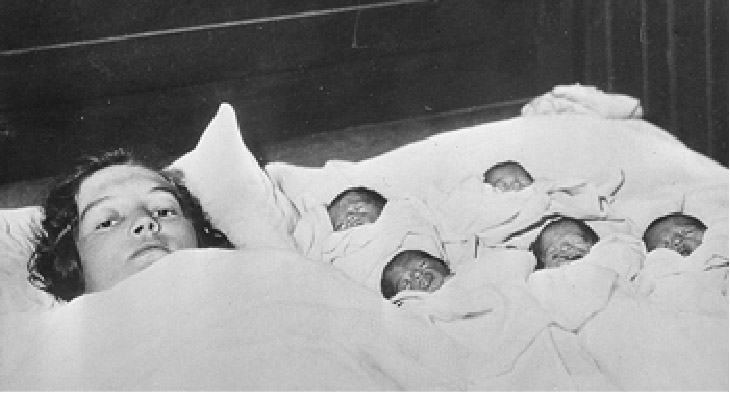
Reporters and promoters descended on the property in waves as they hoped to catch a glimpse of the “miracle babies”, but were kept away by Grandfather Olivier Dionne and his pitchfork. One set of promoters from the Chicago World’s Fair did manage to connect with the father with a proposal to display the young girls. On the advice of Dr. Dafoe and his priest Father Daniel Routhier, Mr. Dionne signed the contract. When the news hit the papers, the public was upset that the Americans were taking “their” babies, and Mr. Dionne quickly renounced the contract. In order to keep the quintuplets safe from the promoters, the parents signed over custody of their girls to the Red Cross, who would manage the affairs of the sisters for a period of two years. Part of this involved the construction of a hospital across the road where the girls would live separate from their family. Although this agreement was to end after two years, the Ontario government feared further exploitation of the sisters if they were returned to their family following performances on stage by the parents in Chicago in February of 1935. To combat this, Premier Mitchell Hepburn forced “The Dionne Act” through government and in 1935 they were officially made Wards of the Crown until they turned eighteen. The irony of the government removing the girls from their family to protect them from exploitation only to be then used as a tourist attraction to bring three-million people to the area is not lost.
“Quintmania” Takes Over
“Showings” first began with the nurses standing on the patio of the nursery, holding each baby up to a gathered crowd, with a nameplate to identify which girl it was. As the crowds grew and the demand to see the girls increased, an outdoor observatory was built beside the nursery with a playground inside. Similar to viewing animals in a zoo, the crowds would line up to enter the building to view the girls behind one-way screen that allegedly ensured that the girls couldn’t see or hear the people watching them play. The sisters later corrected this assumption and stated that they were well aware that they were being observed. Soon souvenir shops were built, highways were paved, additional floors were added to hotels, and everybody seemed to be turning a profit from the influx of tourists. With the opening of “Quintland” and the observatory, the babies were available to be seen 2 times a day. Everyone around the world heard of the news of the quintuplets, creating instant celebrity status for the five little girls.
The girls became a five-hundred-million dollar asset to the province of Ontario. They starred in three Hollywood films, and their faces could be found on everything from radios and spoons, to pocket mirrors and dolls. Many celebrities took trips to the North to meet the doctor and view the babies, businesses dramatically increased and it seemed the everybody was making money off the miracle birth. After years of fighting to regain custody, the Dionnes were reunited in 1943 when the entire family moved into a newly built, fifty-thousand dollar (1943 price) building known as “The Big House”. Today, this building is part of Nipissing Manor.
Interesting Facts
The odds of quintuplets are 1 in 57,289,761. A single egg was twinned once to produce Yvonne & Annette, and then twinned twice to produce Cecile and another egg. This other egg split to produce Emilie and Marie. It was only the third set of identical quintuplets in recorded history; they were the only ones to survive more than a few hours in the 500 years previous. Mrs. Dionne had passed an egg-shaped object three months into her pregnancy, and this was believed to have potentially been a sixth child. All were right handed and their hair whorls ran counter-clockwise except Emilie, who was was a mirror twin of Marie and was left handed.
Yvonne Edouida Marie was the first born at 4:10 a.m.
Annette Liliane Marie was the second at 4:25 a.m.
Cecile Marie was the third at 4:40 a.m.
Emilie Marie was the fourth at 4:45 a.m.
Marie Reina Alma was the fifth at 4:57 a.m.
Yvonne and Annette shared an embryonic sac; and Emilie and Marie shared one. Cecile was alone.
Their total weight was 13 pounds 5 ounces, with Yvonne weighing the most at 2 pounds 8 ounces, and Marie weighing 1 pound 8.5 ounces.
Parents and Family
Father: Oliva Dionne was born in 1904 (d. 1979).
Mother: Elzire Legros Dionne was born in 1909 (d. 1986).
They were married September 15, 1925 at the age of 21 and 16. At the time of the Quints being born Elzire was 24 years of age and Oliva was 31. They continued to have children which brought the total to 14 children all together for the Dionnes. Ernest (b. 1926, d. 1995), Rose-Marie (b. 1928, d. 1995), Therese (b. 1929), Leo (b. 1930, d. 1930), Daniel (b. 1932, d. 1995), Pauline (b. 1933), Oliva Jr. (b. 1936, d. 2016), Victor (b. 1938, d. 2007), and Claude (b. 1946, d. 2009).
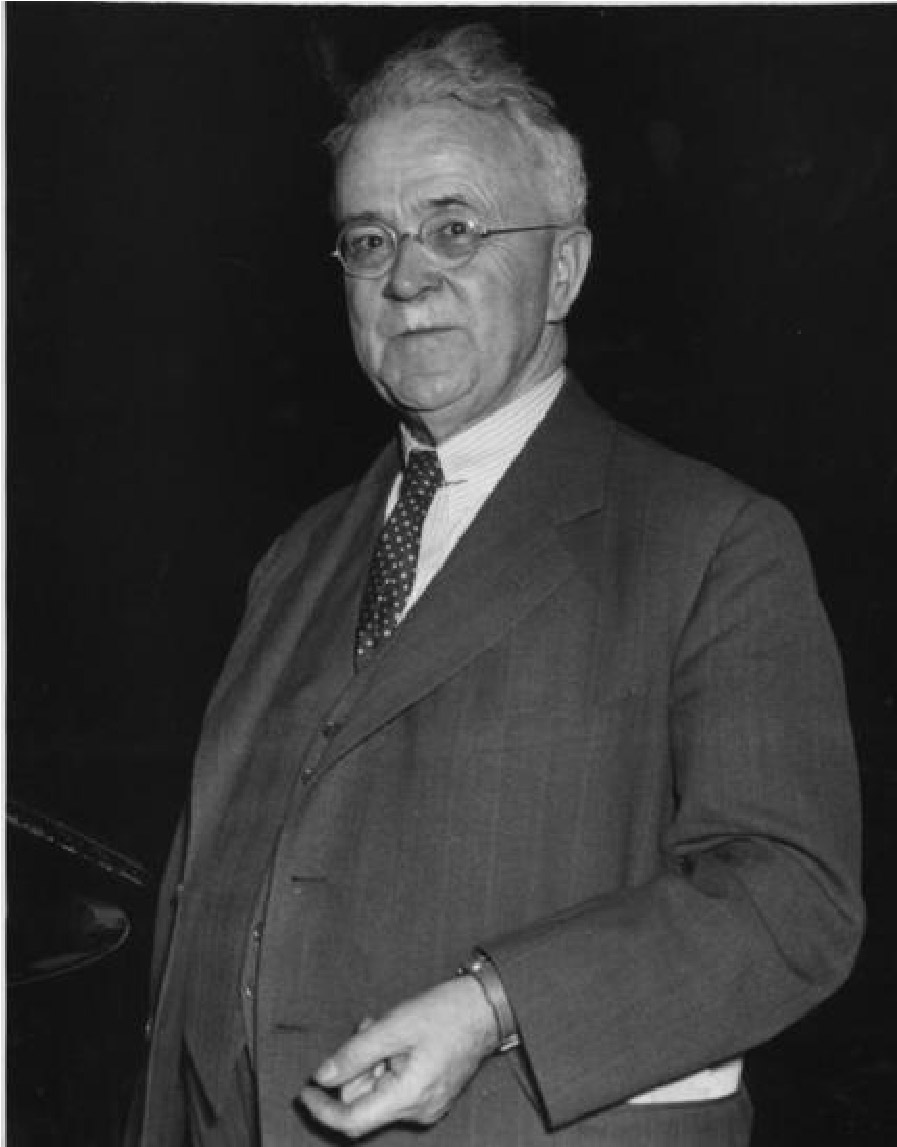
Born on May 29, 1883 in the village of Madoc, Ontario, his parents were William Allan Dafoe (who also was a physician) and Essa Van Deusen. The doctor was the first born in his family; he had seven sisters and one brother.
Dafoe moved to Callander and started his practice on January 2, 1909. He bought an existing practice for $100.00 and paid it back in monthly installments of $10.00.
The Doctor bought this house in 1914; the year that he and his wife Bertha Leila Morrison, a nurse in the area married. She died in 1926 after only twelve years of marriage of pneumonia and meningitis. Mrs. Dafoe left one son, William, who was nine years of age at the time. The Doctor hired a housekeeper, Mrs. Little who had a young daughter, Mary Hannah, and they both lived in the house. Young William eventually went to boarding school in the Toronto area and broke the tradition of becoming a doctor like his father and uncle and became a mechanical engineer. Interesting enough, William’s son, William Jr, became a doctor and specializes in Cardiac Rehabilitation.
For eight years the doctor continued medicine, treating many patients and deliver babies. The doctor was well liked by some of the area people; however, others said he was a peculiar man, who was very reserved and strict. Dr. Dafoe was a surgeon, a dentist, an obstetrician, as well as an accomplished gardener and organ player. He enjoyed taking care of horses, gardening and other chores were his forms of relaxation and was an avid reader – his collection contained at least 1500 volumes. At times, if he liked you, he would lend out his books. Some of his evenings he would spend fiddling with his short-wave radio, and, as there were few radios at the time, he would bring it out onto the porch for others to listen to if there was a special announcement from the Government or Queen.
He had no way of knowing that a day before his 50th birthday he would answer a call to assist with a delivery that would change his life, and the world’s, forever. He would go from being an everyday average country doctor to being known internationally as “The Country Doctor”, he would greet celebrities in his home (it’s said that when Hollywood actor Jimmy Stewart and his wife Gloria came to Callander, the doctor had them wait for him in his office’s waiting room before coming out to greet them in September 1940), his life would play out in a Hollywood film and his name would be known to all.
On June 2, 1943 Dr. Allan Roy Dafoe died at the North Bay Hospital of pneumonia (complications of cancer) at the age of sixty. The doctor had given 27 years to Callander and area residents. For his work with the Dionne Quintuplets, he received the Order of the British Empire.

When Callander’s founder George Morrison and his wife came up from Bracebridge, and staked out their future town-site in 1880, there were only two means of access to Lake Nipissing at the time. The first, and oldest, was the Ottawa / Mattawa / La Vase / French River route forged by the area’s First Nations thousands of years ago, and later explored by Champlain and used by the fur trade for over 200 years.
In 1875, the Rosseau – Nipissing Colonization Road was completed, linking Muskoka with the Nipissing region. Stage coach services provided access to settlers, one of whom was George Morrison. In 1880, Morrison constructed a raft at Nipissing Village and hauled his belongings to the shoreline of what is now the town of Callander – named after his parents’ birthplace in Scotland.
Callander’s Dock has evolved and changed over the last 120+ years. Sailboats, rowboats, and steamboats of various shapes and sizes used to moor here, giving their crews access to the village for accommodations, fuel and supplies. At that time, steamers were used almost exclusively for logging and lumber mill operations on Callander Bay and Lake Nipissing, and provided access to areas where there were no roads.
The Callander waterfront could have been very different. In the early 1900s, there was a lot of work done on the Georgian Bay Ship Canal (see Georgian Bay ship canal, 1908 : typical views on the projected route, University of Calgary digital archives), which would have saved hundreds of kilometers on the route from Lake Superior to the Saint Lawrence. Ships would come across Georgian Bay to the French River, through locks to Lake Nipissing, a canal to Trout Lake, and then various locks down the Mattawa River and Ottawa River to Montreal. Callander would have been a major shipping port. And in the plan below, the proposed Canadian Northern Dock completely overwhelms the existing Callander dock. Sir Wilfred Laurier promised to build it if he won the 1911 election. He lost, and it was never built.
There have been at least three versions of the dock. The oldest, as pictured below, is a straight dock with the familiar “L” shape of the later two docks. In the middle of the picture the Darling family houseboat (the Wasa Lily) can be seen at its usual mooring spot at the mouth of the Callander “Crik”. To the right in the picture is the White House Hotel, which helps to date the picture as it is the second version of the hotel (which was rebuilt in 1906) before it burned for the final time on December 27, 1914.

The dock was originally owned by the Grand Trunk Railway (GTR), later part of the Canadian National Railway. The dock was acquired by the federal government during the Second World War, and then by the Municipality in 1999. Given the importance of shipping on the lake, and to the local economy in Callander, Public Works Canada commissioned the construction of the first Callander Wharf in 1905.
This new wharf was extended out into Callander Bay on a rock and crib foundation. It was 80 feet long, and 20 feet wide, had a gravel approach onshore and has the familiar “L” shape.
This dock was destroyed by a major storm on May 14 2009. The north-south section was mostly washed away, just leaving the large rocks used to anchor it. Damage and condition assessment work began on July 15, 2009, conducted by an underwater dive team from Soderholm Maritime Services Inc.
The latest version of the dock was completed in 2014. It still has an “L” shape, but with the north-south section slightly shorter, and with a covered section for protection in any sudden rain.
Photos of the reconstruction of the dock are available upon request.
Pulling the Chief Commanda II onshore for winter storage, October 2012
At the end of its scheduled cruising season, the Chief Commanda II is pulled onshore and stored through the winter beside the dock in Callander. Maintenance and repainting on the bottom of the hull is also done while the vessel is out of the water. Here are some photos when ‘the Chief’ was pulled onshore in October of 2012.

Having served the community for well over 100 years, the Callander Dock remains an asset and landmark in our town today. Recognizing this, the dock was refurbished and will serve the community for another 100+ years!
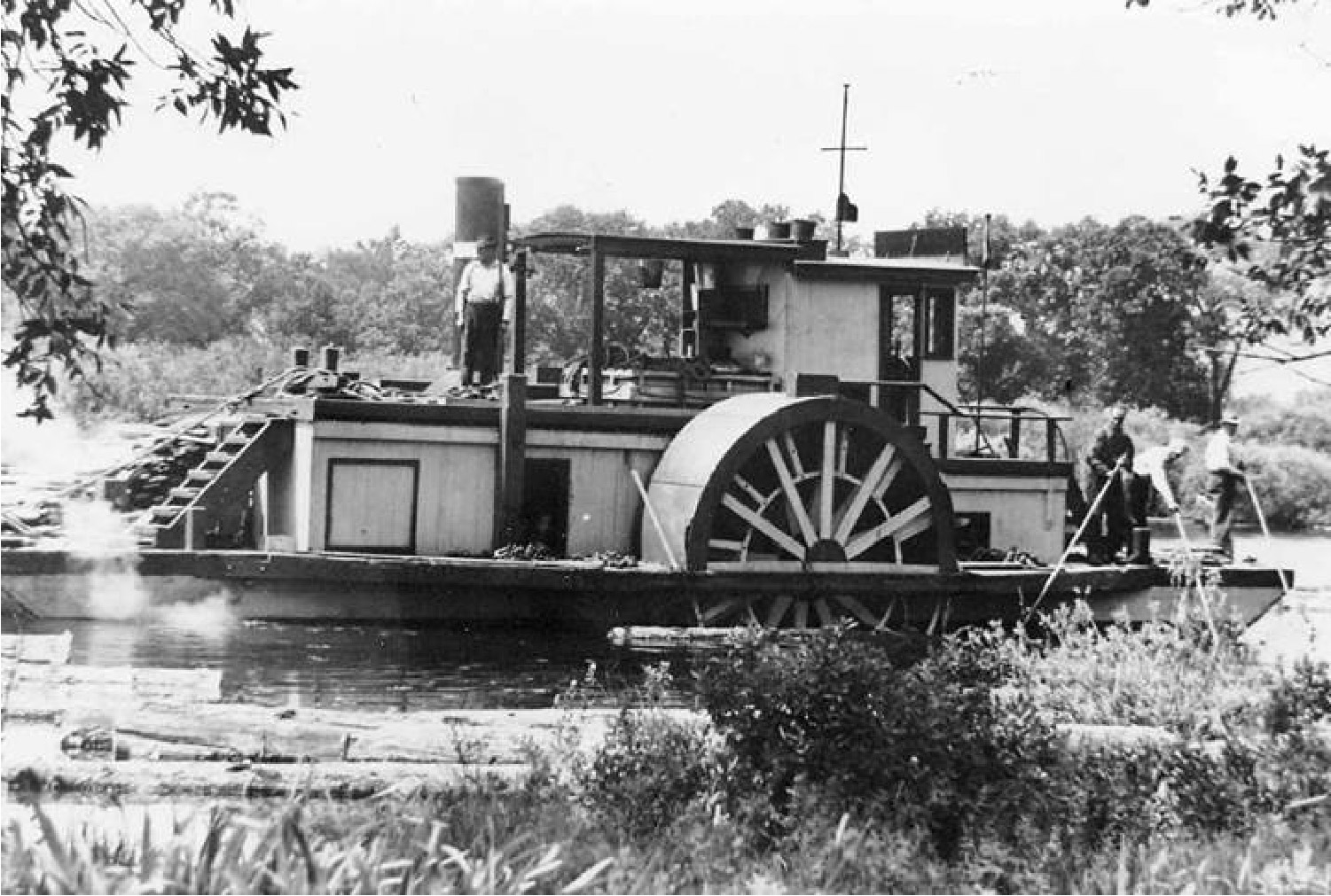
There were around 54 working ships on Lake Nipissing. Below, we highlight 6 of them.
The Woodchuck (built in 1925) was an “alligator” tugboat that could retrieve jammed logs in shallow water. They were slow but powerful and could haul up to 4,000 logs.
The Seagull 1 (built in 1906 by J.B Smith and Sons) was a steam tugboat that was used to haul booms of logs across Lake Nipissing. Its hull required extensive repairs so the engine was removed and was taken out of use.
The Seagull II (built in 1930, and first owned by Armstrong Towing Co.) also hauled log booms. By the mid 1930′s the lumber trade deteriorated greatly and it became a tour boat making trips down the French River. Many Quintland tourists went on these excursions. In 1940 it was purchased by J.B Smith and Sons and became a tugboat once more; it was used until 1960 when it became more economical to transport by land. Intended for display at Lee Park in North Bay, the Seagull II was lost to the scrapyard when it was unknowingly sold off and destroyed – to the anger of the local community. The museum retains her original steam-whistle and life-jackets today.

The Screamer was built in 1922 by J.B Smith and Sons. Its hull was top-heavy and tended to list dangerously in turns; another hull was built on the outside to stabilize it. It could haul up to 10,000 logs. By 1940 the Screamer’s hull was badly rotted so the wheelhouse and engine were removed and it was towed by the Woodchuck to Smith Island where it was doused with gas and set on fire. The Northern Belle was a passenger vessel built in 1905 and owned by J.A Clark of Sturgeon Falls. It was the ‘jewel’ of Lake Nipissing during the 1910′s and 1920′s. In 1926 it burned to the water line and then sank in shallow water at the dock in North Bay.
The Chief Commanda was a steel-hulled tour boat, assembled and launched at Callander by Ontario Northland Boat Lines in 1946. This diesel vessel was retired in 1975, spent many years in Dokis on the French River, and is now located at North Bay’s waterfront as a restaurant.
It was replaced with the current Chief Commanda II, Canada’s first all-aluminum catamaran in 1975. This sight-seeing vessel was prefabricated by Marlin Yacht Company of Gananoque, Ontario and assembled and launched in Callander. The Chief Commanda II offers tours on Lake Nipissing, Callander Bay and the French River and is based at the North Bay Wharf. It spends the winters pulled up on shore in Callander beside the municipal dock.
From the height of “Quintmania” during the Depression years up to the present time, the home of Dr. A.R. Dafoe and the Callander Museum has received a variety of notable guests. Check out our past guests below, and be sure to “come up and see us sometime”!
Brooke Shields and Beau Bridges – February 21st, 2016

On Sunday February 21st, the Callander Bay Heritage Museum played host to a couple of special guests. Brooke Shields and Beau Bridges, as well as members of their production crew, took time out of their busy filming schedule to spend the afternoon with us at the museum! It was a short notice visit, but we managed to connect with a few supporters of the museum and invited them along. Councillor Virginia Onley and her niece Jillian Scott-Picard, museum board members Linda Masson and Garry Besserer, and Michael Dufresne whose father Alex was instrumental in setting up the museum in 1979; the gallery is named in his honour. As well, museum staff Carol Pretty, Deryk Hagar, and Natasha Wiatr were on-hand to welcome the visitors and give them a tour of our museum.
Beau Bridges had a special interest in the museum because of his portrayal of Dr. Dafoe in the 1994 tv-movie Million Dollar Babies. He appreciated the opportunity to explore the Doctor’s original house, as well as examine many old photographs of the Doctor. We even asked him to pose beside a large photograph of Dr. Dafoe, and he was happy to do so!
The movie has some interesting trivia tidbits behind it. As there was not a set of female quintuplets that existed at the time of filming, two sets of triplets had to be cast to play the roles of the quints. The newborn quintuplets were not actual babies, but animatronics built especially for the movie. Finally, the movie earned 6 Gemini wins with an additional 2 nominations and was nominated for an ASC award for Outstanding Achievement in Cinematography in a Mini-series.
Brooke Shields also appreciated the opportunity as she explained to us that her mother had a set of Mme. Alexander’s dolls of the Quints and when Brooke was older she gave them to her; she always had a fascination with the Dionne Quintuplets. Being able to tour the museum and watch old news reels from the 1930s and look at our photographs and artefacts was a real treat for her.
Everyone had a wonderful afternoon, and we want to thank Beau and Brook for taking time out of their busy schedule to hang out at the museum with us! Some of you may remember an exhibit we put on a few years ago entitled “When Hollywood Came to Callander” … well, a few years later… Hollywood came to Callander … again!

The Callander Museum had some very special visitors! In fact, it felt just like a family reunion and home-coming. Barbara Green (husband Orland), her daughter Sharon (husband Frank), and their children Katrina, Alex and Emily visited the Museum and Gallery on August 22, 2015. What made this visit so remarkable? Barbara is the grand-daughter of Dr. Allan Roy Dafoe, physician to the Dionne Quints and his wife, Bertha L. Morrison! So, not only did we have Dr. Dafoe’s grand-daughter along for a visit, we also had his great grand-daughter, and great, great-grand children exploring the old family home as well. We also received summer visits from the descendants of the Darling Family, Smith Family, Legros Family, Dionne Family, and Wice Family — all big names in Callander’s 130 year history!